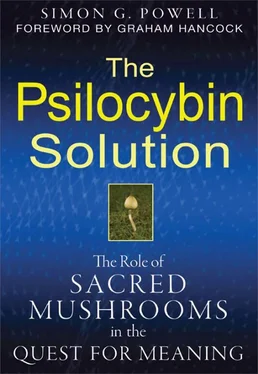As yet unnamed, its chemical structure still unknown, psilocybin thus began its gradual infiltration of the modern technological world, flowing for the first time in and out of the nervous systems of Westerners, facilitating a spectacular kind of cerebral information processing in which the blazing divinity of Nature was potentially discernible. The world would never be the same again as intellectuals, artists, and spiritual seekers with the aid of the psilocybin mushroom began scratching away at the restricted surface of normal everyday awareness. Such intrepid peering beyond the confines of routine perception seemed to reveal much, much more in the way of reality, allowing access to information of the most stimulating and enchanting kind, as if the mushroom was able to offer up all of Nature’s best-kept secrets.
Despite the widespread interest generated by his Life piece, Wasson later chose, perhaps wisely, to distance himself from the 1960s psychedelic hippie culture, revolving as it was around synthetic LSD. Instead, he concerned himself with investigating the role of the fly agaric mushroom in ancient Indo-European Soma cults. He also went on to make invaluable contributions to our knowledge of the use of psilocybin mushrooms by the Aztec and Mayan civilizations of ancient Mesoamerica, and we shall now step briefly back in time to view these historical entheogenic traditions before bringing the history of psilocybin fully up to date.

TWO
An Ancient Form of Communion
The discovery of the shamanic use of psilocybin among contemporary Mexican Indians was indicative of a sacred tradition that, although almost buried, had its roots firmly set in the glories of past civilizations. In particular, the mighty Aztec empire had been familiar with the mushroom, and the various documents written by Spanish conquistadors almost five hundred years ago, which mention mushroom use by the Aztecs, can be reanalyzed according to what we now know of the actual entheogenic experience. Psilocybin emerges as no mere incidental feature of the natural world, restricted to secretive and isolated use; rather, its ritual role as a potent sacrament was overtly established within the very fabric of ancient Mesoamerican society. Until, that is, it came under the merciless gaze of the Catholic Spanish conquistadors.
The Aztecs were an immensely powerful civilization whose cultural achievements are ranked by some in the same league as those of ancient Egypt and Babylonia. Religious ideology permeated all aspects of Aztec society, driving them to conquest and expansion and giving rise to their infamous bloody human sacrifices on a scale that cannot fail to shock.
Located in the Central Valley of Mexico, the Aztec capital Tenochtitlán (now Mexico City) reached its peak of power and magnificence immediately prior to the arrival of Hernán Cortés and his gold-rushing Spanish army in 1519. With the advent of the Spanish conquest, all aspects of Aztec religion, including the use of the psilocybin mushroom, were systematically wiped out, condemned as devilish heresy.
To the invading Spanish clergy, the Aztecs’ claim that certain mushrooms (some two dozen or so psilocybin-containing species are indigenous to Mexico) were teonanácatl, or “God’s Flesh,” was to admit to some blasphemous unholy communion. In the Roman Catholicism touted by the marauding conquistadors, communion with the divine was not based on personally revealed knowledge or gnosis. Absolutely not. Rather it was the case that “inside” information concerning the divine was considered acceptable only if one was connected to a formally established religious hierarchy within which one accepted, without question, its most cherished doctrines.
In other words, the organized drive of Catholicism that descended upon the Aztec nation derived its power structure through force-feeding religious dogma to its adherents. To openly question this dogma, or to criticize it, could and did mean death five hundred years ago. One is therefore hard-pressed to conceive of a more heretical act than that of the Aztecs’ consumption of supposedly divine mushrooms. The Spanish Catholic clergy, eager to spread their faith, would have been utterly appalled at the concept of eating some foul and unsightly fungus in order to facilitate divine communion. As we shall see, this negative reaction was clearly reflected in the lively written Spanish accounts of Aztec customs. To be sure, the intense disgust generated within the orthodox religious minds of the Spanish priests echoes the hatred meted out to women accused of being satanic witches in medieval Europe, as they too were found guilty of possessing heretical botanical knowledge. Whereas the Aztecs employed psilocybin mushrooms to induce numinous states of consciousness, the witches of the Middle Ages achieved similar states of mind by utilizing plants like henbane and belladonna. Historically speaking, the spiritual use of plants and fungi tends to generate the same blunt response in the male psyche of any monotheistic culture—namely, unremitting persecution. The Aztec religion succumbed to just such a fate.
The Catholic Constabulary Take Note
The Aztecs’ use of psilocybin is clearly revealed in many of the records made by Spanish chroniclers at the time of the conquest, who diligently recorded their own observations and translated Aztec historical documents as well. For instance, during the coronation of Montezuma the second in 1502, we learn that teonanácatl was consumed during the celebrations. Many war captives were slaughtered to honor the new king, their hearts torn out and offered to the gods. After the grisly sacrifices, the celebrants were bathed in blood and then given raw psilocybin mushrooms to eat.
Perhaps it was this kind of terrible juxtaposition that helped the finger of heresy point toward the mushroom. After all, a mass bloody sacrifice followed by some strange ritual fungal inebriation is a hellish concept to the West, yet it was bound with the Aztecs’ desire to supplicate their pantheon of gods. Blood spilled in the name of religion whether through war or sacrifice is, unfortunately, a kind of pious tradition that highlights the immense power of the religious impulse over the human mind and soul. The gods of the Aztecs were deemed real, and they had to be worshipped and placated.
At any rate, the Aztecs utilized psilocybin in their religious rituals and engaged in various other rites that would have appeared horrendously alien to the invading Spanish, who were unlikely to react in the manner of refined social anthropologists. The excessive sacrifices together with the ingestion of psychoactive mushrooms must have sorely confused the Spanish invaders. To be sure, while they were at once amazed at the glorious wealth and regality of the Aztec cities that they encountered, they were less enthusiastic about the underlying psychological forces that had led to the physical magnificence set in stone.
Further accounts from the occupying Spanish clergy reveal the Aztecs’ use of psilocybin. The following testimonies—which paint a sometimes vivid picture of Aztec tradition—are detailed in Wasson’s The Wondrous Mushroom . For example, Diego Durán, a sixteenth-century Dominican friar translating a document in Nahuatl (the language spoken by the Aztecs), writes of the coronation of Tizoc in 1481:
And all the lords and grandees of the provinces rose and, to solemnize further the festivities, they all ate of some woodland mushrooms, which they say make you lose your senses, and thus they sallied forth all primed for the dance. {4} 4 1. Wasson, The Wondrous Mushroom, 200.
Читать дальше












